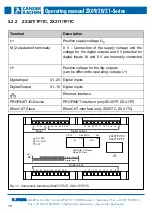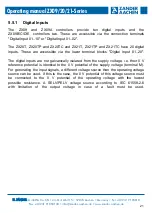
H. ZANDER GmbH & Co. KG • Am Gut Wolf 15 • 52070 Aachen • Germany • Tel +49 241 9105010
Fax +49 241 91050138 • [email protected] • www.zander-aachen.de
29
Operating manual ZX09/20/21-Series
5.5.7 TTL differential signal inputs (only ZX09A, ZX09D, ZX09E)
The SSI or RS-485 interfaces can also be used to connect sensors with TTL differ-
ential outputs, e.g. corresponding incremental encoders with rectangular TTL out-
puts. Up to four TTL differential inputs are available via the "SSI" and "RS485" inter-
faces (see also section 5.5.9, Connecting the inputs/outputs for TTL differential
signals).
In EX_PRESS 5, the signals are read into the control system by software via the
following function blocks and can then be integrated into the logic of the user
program:
RS485_In_11 for the cable pair Ck+ and Ck– of the SSI-port
RS485_In_12 for the cable pair D+ and D– of the SSI-port
RS485_In_21 for the cable pair 1+ and 1– of the RS-485-port
RS485_In_22 for the cable pair 2+ and 2– of the RS-485-port.
5.5.8 TTL differential signal outputs (only ZX09A, ZX09D, ZX09E)
The SSI or RS-485 interfaces can also be used as differential outputs to connect
actuators with TTL differential inputs. Up to four TTL differential inputs are available
via the "SSI" and "RS485" interfaces (see also section 5.5.9, Connecting the
inputs/outputs for TTL differential signals).
The TTL differential outputs are set up in EX_PRESS 5 by software using the
following function blocks:
RS485_Out_11 for the cable pair Ck+ and Ck– of the SSI-port
RS485_Out_12 for the cable pair D+ and D– of the SSI-port
RS485_Out_21 for the cable pair1+ and 1– of the RS-485-port
RS485_Out_22 for the cable pair 2+ and 2– of the RS-485-port
5.5.9 Connection of the In-/Outputs for the TTL differential signals
The wiring of the inputs for TTL differential signals is made via terminals 1+ and 1- or
2+ and 2- of the RS-485 interface or terminals Ck+ and Ck- or D+ and D- of the SSI
interface. The connection is made via shielded cables stranded in pairs. Connect the
cable shield at one end as close as possible to the terminals of the controller with a
low-resistance shielding rail at PE potential. The type of wiring is identical with the
connection of an SSI encoder (see Fig. 18).
















































